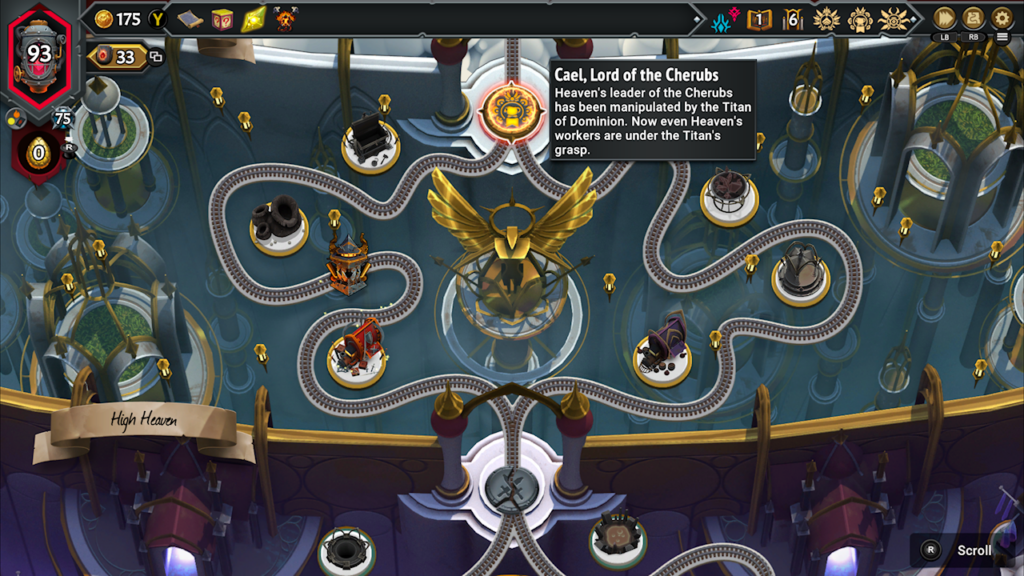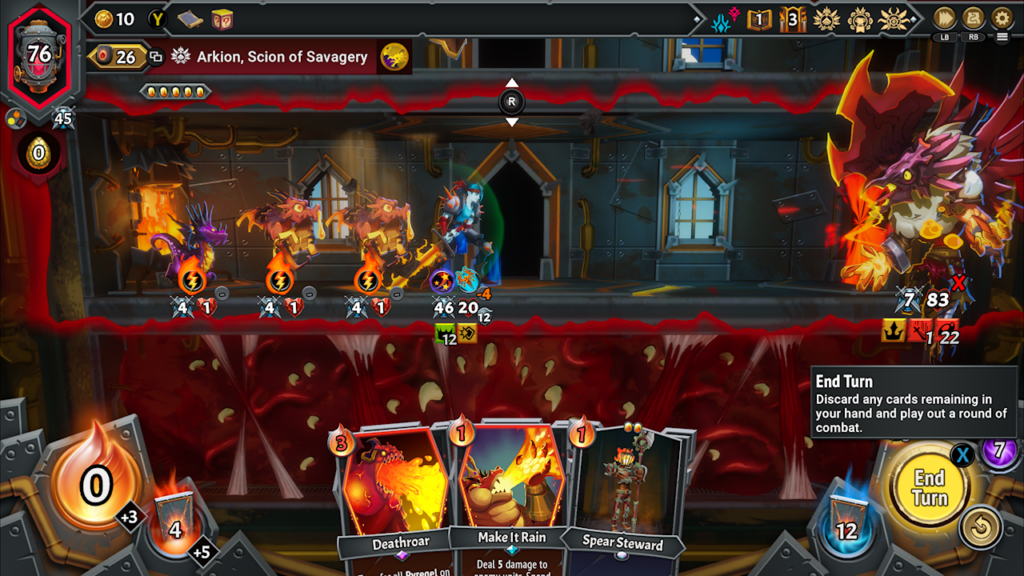I didn’t expect to lose sleep over a rogue-like deck-building tower defence game. But here I am, several runs deep into Monster Train 2, chasing the perfect synergy while ignoring the clock. Whether I was experimenting with the latest clan, unlocking new champions, or tiptoeing through Endless Mode, one thing became clear: this is a sequel that doesn’t just rest on the rails laid by its predecessor, it accelerates past them.
Hell on Track
Monster Train 2 builds confidently on the structure of the original game. Where the first had players defending Hell from celestial forces, this time you’re rising out of Hell, through Heaven and the Abyss, to stop the rampaging Titans. The story sees demons and angels uniting, with you commanding dual clans aboard a vertical battlefield: your train. Enemies attack from the bottom up, climbing three deployable floors before reaching the top level where your vulnerable Pyre resides. Let them damage your Pyre enough, and your run ends in flames.
The core loop remains intact: choose two clans (one primary, one allied), a Pyre Heart, and a champion with one of three upgradable skill paths. From there, every decision matters. The game demands that you commit to a build, streamline your deck, and make surgical choices at every stop on the route to victory. Each run is a tactical puzzle.
Decks, Dragons, and Destiny
At launch, Monster Train 2 offers five fresh clans, each mechanically distinct and creatively designed. The Pyreborne clan, for example, specialises in elemental buffs like Pyregel and damage-over-time effects, while the Banished bring a more aggressive, unit-based approach. As you play, you unlock alternate champions (like Talos for the Banished and Lady Gilda for the Pyreborne), each with their own starter decks and unique tactical flavour.
I leaned heavily into a synergy involving a Sweep unit (attacking all enemies on a floor), stacked with Multistrike and Valor bonuses, reinforced by armour spells and artefacts that supercharged my damage output. It felt surgical. Tense. And ultimately victorious. One spell-hating final boss even forced me to pivot mid-run, relying solely on passive gains and minimal unit count to survive. It’s this kind of dynamic, reactive gameplay that makes Monster Train 2 shine.
Ride of the Replayables
Progression is a constant carrot-dangling delight. Clans earn XP after every run—win or lose—unlocking new cards and champions. Pyre Hearts, the customizable cores of your train, offer passive perks that dramatically alter strategy. Covenant Ranks let you ramp difficulty from 1 to 10, and mutators twist the rules even further. Daily and community challenges provide curated runs for those who want more variety, while the new Dimensional Portal unlocks puzzle-style scenarios with unique mutator setups and long-term rewards.
The true test of your builds, though, lies in Endless Mode. After completing a run, you can continue with your current deck and artefacts through increasingly punishing battles. Between fights, you choose modifier pairs: one helpful, one harmful. These are no joke. One offered me a card removal… at the cost of a curse that randomly inflated spell costs each turn. Another would restore my Pyre’s health, but at the cost of -6 attack on all my units. It’s an endurance test for both your cards and your tactical thinking.
Bells, Whistles, and Guitars
Visually, Monster Train 2 uses a very colourful, hand-drawn art style, with minimalistic animations that preserve the detailed artwork displayed on the cards when units are played. It’s a look that leans into fantasy excess—bold, saturated, and vibrant to a fault. For some, it might be striking; for others, like myself, it felt a bit too busy. The sheer density of colour and visual elements sometimes caused things to look like they were stuck on the background without fully blending in or supporting a cohesive visual idea, making it harder to parse information at a glance. The style is certainly distinctive, but it’s also an acquired tast, and one that could benefit from a bit more restraint.
As for the sound design, it’s a mixed bag. The soundtrack leans hard into rock made with digital instruments (as opposed to real instruments), with battle themes that evoke old-school Final Fantasy boss energy. At first, it’s hype-inducing. After five or six runs, it wears thin. I found myself defaulting to podcasts or playlists for longer sessions. That said, there’s definitely an audience for the soundtrack’s energy, and it pairs well with the visual intensity.
Carriage of Consequences
What makes Monster Train 2 so deeply compelling is that every choice matters. Clan combinations, champion upgrade paths, artefact selections, unit enhancements, and even which random event to pursue contribute to either your glorious triumph or spectacular failure. The randomness feels curated rather than cruel, and even in defeat, you’re constantly unlocking new tools that give your next run an edge.
Even when you lose (and you will), you come away with new ideas, new cards, and new possibilities. It’s the kind of game that has you starting a new run the moment the last one ends—because surely this time, the combo will click.
Conclusion
Monster Train 2 is everything a sequel should be: it respects what worked before, polishes what didn’t, and adds enough new content to feel undeniably fresh. It’s dangerously addictive, deeply strategic, and richly replayable. With brand-new clans, new card types like Room and Equipment cards, dozens of unlockables, puzzle challenges, and an Endless Mode that truly tests your deckbuilding discipline, there’s no shortage of tracks to ride.
Returning players will feel right at home—and will look amazed at the heap of new content—while newcomers will probably get hooked before they even realise it. This game is a masterclass in roguelike deckbuilding.





